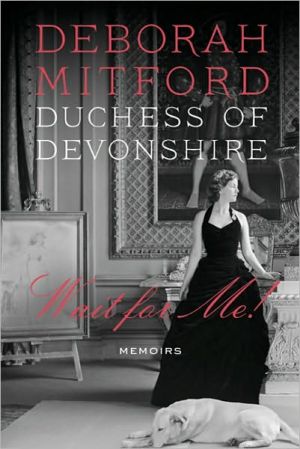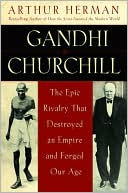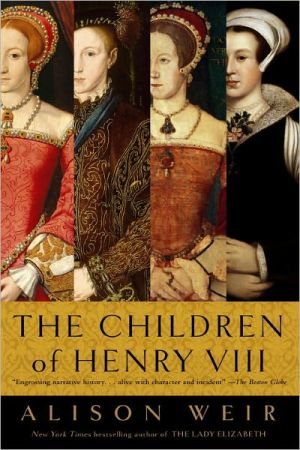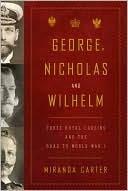The Bolter: The Story of Idina Sackville, Who Ran Away to Become the Chief Seductress of Kenya's Scandalous "Happy Valley Set"
A San Francisco Chronicle Best Book of the Year An O, The Oprah Magazine #1 Terrific Read In an age of bolters—women who broke the rules and fled their marriages—Idina Sackville was the most celebrated of them all. Her relentless affairs, wild sex parties, and brazen flaunting of convention shocked high society and inspired countless writers and artists, from Nancy Mitford to Greta Garbo. But Idina’s compelling charm masked the pain of betrayal and heartbreak. Now Frances Osborne explores...
Search in google:
She was irresistible. She inspired fiction, fantasy, legend, and art.Some say she was “the Bolter” of Nancy Mitford’s novel The Pursuit of Love. She “played” Iris Storm in Michael Arlen’s celebrated novel about fashionable London’s lost generation, The Green Hat, and Greta Garbo played her in A Woman of Affairs, the movie made from Arlen’s book. She was painted by Orpen; photographed by Beaton; she was the model for Molyneaux’s slinky wraparound dresses that became the look fo the age—the Jazz Age.Though not conventionally beautiful (she had a “shot-away chin”), Idina Sackville dazzled men and women alike, and made a habit of marrying whenever she fell in love—five husbands in all and lovers without number.Hers was the age of bolters, and Idina was the most celebrated of them all.Her father was the eighth Earl De La Warr. In a society that valued the antiquity of families and their money, hers was as old as a British family could be (eight hundred years earlier they had followed William the Conqueror from Normandy and been given enough land to live on forever . . . another ancestor, Lord De La Warr, rescued the starving Jamestown colonists in 1610, became governor of Virginia, and gave his name to the state of Delaware). Her mother’s money came from “trade”; Idina’s maternal grandfather had employed more men (85,000) than the British army and built one third of the world’s railroads.Idina’s first husband was a dazzling cavalry officer, one of the youngest, richest, and best-looking of the available bachelors, with “two million in cash.” They had a seven-story pied-à-terre on Connaught Place overlooking Marble Arch and Hyde Park, as well as three estates in Scotland. Idina had everything in place for a magnificent life, until the assassination of Archduke Franz Ferdinand caused the newlyweds’ world—the world they’d assumed would last forever—to collapse in less than a year.Like Mitford’s Bolter, young Idina Sackville left her husband and children. But in truth it was her husband who wrecked their marriage, making Idina more a boltee than a bolter. Soon she found a lover of her own—the first of many—and plunged into a Jazz Age haze of morphine. She became a full-blown flapper, driving about London in her Hispano-Suiza, and pusing the boundaries of behavior to the breaking point. British society amy have adored eccentrics whose differences celebrated the values they cherished, but it did not embrace those who upset the order of things. And in 1918, just after the Armistice was signed, Idina Sackville bolted from her life in England and, setting out with her second husband, headed for Mombasa, in search of new adventure.Frances Osborne deftly tells the tale of her great-grandmother using Idina’s never-before-seen letters; the diaries of Idina’s first husband, Euan Wallace; and stories from family members. Osborne follows Idina from the champagne breakfasts and thé dansants of lost-generation England to the foothills of Kenya’s Aberdare moutnains and the wild abandon of her role in Kenya’s disintegration postwar upper-class life. A parade of lovers, a murdered husband, chaos everywhere—as her madcap world of excess darkened and crumbled around her. The Barnes & Noble Review Say you re 13 years old and reading the Sunday paper when you re transfixed by the story of Idina Sackville, a woman so wild, so daring and dazzling and decadent that it seems sinful to let your little sister see it. And when a fight over the newspaper leads your parents to admit that Idina is, in fact, your great grandmother, what do you do? In the case of Frances Osborne, who suddenly found herself related to one of the most scandalous black sheep of one of England s oldest families, you become obsessed. And then, when you re old enough, you write The Bolter. The relative whose shocking life had caused her to be scrubbed from the family tree became Osborne s passion. And little wonder. Idina, though not a great beauty, was irresistible to men and women alike. She married five times (thus, the Bolter) and had countless lovers. She threw grand dinner parties and notorious spouse-swapping house parties. She had a farm in Africa, two abandoned sons in England, and an utter lack of interest in a conventional life. Though Idina s life was chronicled in the newspapers and scandal sheets of her day, Osborne, an author and journalist, brings depth and context to her infamous great-grandmother. Through interviews with family members and by poring over letters and diaries, Osborne gets beyond the salacious and sensational and introduces us to a real woman. Dense with detail, The Bolter can occasionally be heavy going. But Idina, as mesmerizing as she is doomed, saves it. --Veronique de Turenne
Chapter 1\ Thirty years after her death, Idina entered my life like a bolt of electricity. Spread across the top half of the front page of the Review section of the Sunday Times was a photograph of a woman standing encircled by a pair of elephant tusks, the tips almost touching above her head. She was wearing a drop-waisted silk dress, high-heeled shoes, and a felt hat with a large silk flower perching on its wide, undulating brim. Her head was almost imperceptibly tilted, chin forward, and although the top half of her face was shaded it felt as if she was looking straight at me. I wanted to join her on the hot, dry African dust, still stainingly rich red in this black-and-white photograph.\ I was not alone. For she was, the newspaper told me, irresistible. Five foot three, slight, girlish, yet always dressed for the Faubourg Saint-Honoré, she dazzled men and women alike. Not conventionally beautiful, on account of a “shotaway chin,” she could nonetheless “whistle a chap off a branch.” After sunset, she usually did.\ The Sunday Times was running the serialization of a book, White Mischief, about the murder of a British aristocrat, the Earl of Erroll, in Kenya during the Second World War. He was only thirty-nine when he was killed. He had been only twenty-two, with seemingly his whole life ahead of him, when he met this woman. He was a golden boy, the heir to a historic earldom and one of Britain’s most eligible bachelors. She was a twice-divorced thirty-year-old, who, when writing to his parents, called him “the child.” One of them proposed in Venice. They married in 1924, after a two-week engagement.\ Idina had then taken him to live in Kenya, where their lives dissolved into a round of house parties, drinking, and nocturnal wandering. She had welcomed her guests as she lay in a green onyx bath, then dressed in front of them. She made couples swap partners according to who blew a feather across a sheet at whom, and other games. At the end of the weekend she stood in front of the house to bid them farewell as they bundled into their cars. Clutching a dog and waving, she called out a husky, “Good-bye, my darlings, come again soon,” as though they had been to no more than a children’s tea party.\ Idina’s bed, however, was known as “the battleground.” She was, said James Fox, the author of White Mischief, the “high priestess” of the miscreant group of settlers infamously known as the Happy Valley crowd. And she married and divorced a total of five times.\ IT WAS NOVEMBER 1982. I was thirteen years old and transfixed. Was this the secret to being irresistible to men, to behave as this woman did, while “walking barefoot at every available opportunity” as well\ as being “intelligent, well-read, enlivening company”? My younger sister’s infinitely curly hair brushed my ear. She wanted to read the article too. Prudishly, I resisted. Kate persisted, and within a minute we were at the dining room table, the offending article in Kate’s hand. My father looked at my mother, a grin spreading across his face, a twinkle in his eye.\ “You have to tell them,” he said.\ My mother flushed.\ “You really do,” he nudged her on.\ Mum swallowed, and then spoke. As the words tumbled out of her mouth, the certainties of my childhood vanished into the adult world of family falsehoods and omissions. Five minutes earlier I had been reading a newspaper, awestruck at a stranger’s exploits. Now I could already feel my great-grandmother’s long, manicured fingernails resting on my forearm as I wondered which of her impulses might surface in me.\ “Why did you keep her a secret?” I asked.\ “Because”—my mother paused—“I didn’t want you to think her a role model. Her life sounds glamorous but it was not. You can’t just run off and . . .”\ “And?”\ “And, if she is still talked about, people will think you might. You don’t want to be known as ‘the Bolter’s’ granddaughter.”\ MY MOTHER WAS RIGHT to be cautious: Idina and her blackened reputation glistened before me. In an age of wicked women she had pushed the boundaries of behavior to extremes. Rather than simply mirror the exploits of her generation, Idina had magnified them. While her fellow Edwardian debutantes in their crisp white dresses merely contemplated daring acts, Idina went everywhere with a jet- black Pekinese called Satan. In that heady prewar era rebounding with dashing young millionaires—scions of industrial dynasties—Idina had married just about the youngest, handsomest, richest one. “Brownie,” she called him, calling herself “Little One” to him: “Little One extracted a large pearl ring—by everything as only she knows how,” she wrote in his diary.\ When women were more sophisticated than we can even imagine now, she was, despite her small stature, famous for her seamless elegance. In the words of The New York Times, Idina was “well known in London Society, particularly for her ability to wear beautiful clothes.” It was as if looking that immaculate allowed her to behave as disreputably as she did. For, having reached the heights of wealth and glamour at an early age, Idina fell from grace. In the age of the flappers that followed the First World War, she danced, stayed out all night, and slept around more noticeably than her fellows. When the sexual scandals of Happy Valley gripped the world’s press, Idina was at the heart of them. When women were making bids for independence and divorcing to marry again, Idina did so—not just once, but several times over. As one of her many in-laws told me, “It was an age of bolters, but Idina was by far the most celebrated.”\ She “lit up a room when she entered it,” wrote one admirer, “D.D.,” in the Times after her death. “She lived totally in the present,” said a girlfriend in 2004, who asked, even after all these years, to remain anonymous, for “Idina was a darling, but she was naughty.” A portrait of Idina by William Orpen shows a pair of big blue eyes looking up excitedly, a flicker of a pink-red pouting lip stretching into a sideways grin. A tousle of tawny hair frames a face that, much to the irritation of her peers, she didn’t give a damn whether she sunburnt or not. “The fabulous Idina Sackville,” wrote Idina’s lifelong friend the travel writer Rosita Forbes, was “smooth, sunburned, golden—tireless and gay—she was the best travelling companion I have ever had . . .” and bounded with “all the Brassey vitality” of her mother’s family. Deep in the Congo with Rosita, Idina, “who always imposed civilization in the most contradictory of circumstances, produced ice out of a thermos bottle, so that we could have cold drinks with our lunch in the jungle.”\ There was more to Idina, however, than being “good to look at and good company.” She was a woman with a deep need to be loved and give love in return. “Apart from the difficulty of keeping up with her husbands,” continued Rosita, Idina “made a habit of marrying whenever she fell in love . . . She was a delight to her friends.”\ Idina had a profound sense of friendship. Her female friendships lasted far longer than any of her marriages. She was not a husband stealer. And above all, wrote Rosita, “she was preposterously—and secretly—kind.”\ As my age and wisdom grew fractionally, my fascination with Idina blossomed exponentially. She had been a cousin of the writer Vita Sackville-West, but rather than write herself, Idina appears to have been written about. Her life was uncannily reflected in the writer Nancy Mitford’s infamous character “the Bolter,” the narrator’s errant mother in The Pursuit of Love, Love in a Cold Climate, and Don’t Tell Alfred. The similarities were strong enough to haunt my mother and her sister, two of Idina’s granddaughters. When they were seventeen and eighteen, fresh off the Welsh farm where they had been brought up, they were dispatched to London to be debutantes in a punishing round of dances, drinks parties, and designer dresses. As the two girls made their first tentative steps into each party, their waists pinched in Bellville Sassoon ball dresses, a whisper would start up and follow them around the room that they were “the Bolter’s granddaughters,” as though they, too, might suddenly remove their clothes.\ In the novels, Nancy Mitford’s much-married Bolter fled to Kenya, where she embroiled herself in “hot stuff . . . including horse- whipping and the aeroplane” and a white hunter or two as a husband, although nobody is quite sure which ones she actually married. The fictional Bolter’s daughter lives, as Idina’s real daughter did, in England with her childless aunt, spending the holidays with an eccentric uncle and his children. When the Bolter eventually appears at her brother’s house, she looks immaculate, despite having walked across half a continent. With her is her latest companion, the much younger, non-English-speaking Juan, whom she has picked up in Spain. The Bolter leaves Juan with her brother while she goes to stay at houses to which she cannot take him. “ ‘If I were the Bolter,’ ” Mitford puts into the Bolter’s brother’s mouth, “ ‘I would marry him.’ ‘Knowing the Bolter,’ said Davey, ‘she probably will.’ ”\ Like the Bolter, Idina famously dressed to perfection, whatever the circumstances. After several weeks of walking and climbing in the jungle with Rosita, she sat, cross-legged, looking “as if she had just come out of tissue paper.” And her scandals were manifold, including, perhaps unsurprisingly, a case of horsewhipping. She certainly married one pilot (husband number five) and almost married another. There was a white-hunter husband who, somewhat inconveniently, tried to shoot anyone he thought might be her lover. And, at one stage, she found an Emmanuele in Portugal and drove him right across the Sahara and up to her house in Kenya. He stayed for several months, returning the same way to Europe and Idina’s brother’s house. Idina then set off on her tour of the few British houses in which she was still an acceptable guest, leaving the uninvited Emmanuele behind. This boyfriend, however, she did not marry.\ Even before that, the writer Michael Arlen had changed her name from Idina Sackville to Iris Storm, who was the tragic heroine of his best- selling portrait of the 1920s, The Green Hat, played by Garbo in A Woman of Affairs, the silent movie version of the book. Idina had been painted by Orpen and photographed by Beaton. Molyneux designed some of the first ever slinky, wraparound dresses for her, and her purchases in Paris were reported throughout the American press. When Molyneux had financial difficulties, Idina helped bail him out. In return he would send her some of each season’s collection, delicately ruffled silk dresses and shirts, in which she would lounge around the stone-and-timber shack of the Gilgil Club.\ A FARM HALFWAY UP an African mountain is not the usual place to find such an apparently tireless pleasure-seeker as Idina. Clouds was by no means a shack: by African mountain standards it was a palace, made all the more striking by the creature comforts that Idina—who had designed and built the house—managed to procure several thousand feet above sea level. It was nonetheless a raw environment. Lethal leopard and lion, elephant and buffalo, roamed around the grounds of its working farm, where “Idina had built up one of the strongest dairy herds in Africa,” according to a fellow farmer who used to buy stock from her. Idina took farming immensely seriously, surprising the Kenyans who worked for her with her appetite for hard work. Like them, too, she camped out on safari for weeks on end. But then, as Rosita put it, Idina “was an extraordinary mixture of sybarite and pioneer.”\ Up at Clouds, Idina filled her dining table with everyone visiting the house. She made no distinction between her friends and the people working for her, “including the chap who came to mend the gramophone etc.” The gin flowed. She was “always most hospitable . . . absolutely charming and put one completely at one’s ease and I was bowled over by her,” wrote an acquaintance.\ However, behind this hard work and high living lay a deep sadness.\ When the poet Frédéric de Janzé described his friends (and enemies) in Kenya alphabetically, for Idina he wrote: “I is for Idina, fragile and frail.” When Idina is described, sometimes critically, as living “totally in the present,” it should be remembered that her past was not necessarily a happy place. Driving her wild life, and her second, third, fourth, and fifth marriages, was the ghost of a decision Idina made back in 1918, which had led to that fall from grace. On the day the First World War ended, she had written to her young, handsome, extremely rich first husband, Euan Wallace, and asked for a divorce. She then left him to go and live in Africa with a second husband, in comparison with Euan a penniless man. She went in search of something that she hadn’t found with Euan. And when, not long after, that second marriage collapsed, Idina was left to go on searching. In the words of Michael Arlen’s Iris Storm, “There is one taste in us that is unsatisfied. I don’t know what that taste is, but I know it is there. Life’s best gift, hasn’t someone said, is the ability to dream of a better life.”\ Idina dreamt of that better life. Whenever she reinvented her life with a new husband, she believed that, this time round, she could make it happen. Yet that better life remained frustratingly just out of reach. Eventually she found the courage to stop and look back. But, by then, it was too late.\ When she died, openly professing, “I should never have left Euan,” she had a photograph of him beside her bed. Thirty years after that first divorce she had just asked that one of her grandsons—through another marriage—bear his name. Her daughter, the boy’s mother, who had never met the ex-husband her mother was talking about, obliged.\ At the end of her life, Idina had clearly continued to love Euan Wallace deeply. Yet she had left him. Why?\ The question would not leave me.
The Marriages of Idina Sackville viiiList of Illustrations ixClaridge's Hotel, Mayfair, 1934 3Book 1 Edwardian London 5Book 2 Kenya—Happy Valley 131Notes 30Select Bibliography 319Acknowledgements 323Index 327
\ From Barnes & NobleFrances Osborne's notions about her venerable, staid family tree were shaken to the roots when she began reading the serialization of James Fox's 1983 White Mischief exposé of her aristocratic great-grandmother's drug and alcohol-fueled orgies. According to the book, Lady Idina Sackville's "Happy Valley" set of British expatriates dealt with the loneliness of Kenyan cattle country by excessive imbibing and promiscuity. Almost on the spot, Osborne decided to investigate her much-maligned ancestor. This fully illustrated biography reveals a woman far more complicated and sympathetic than stereotypical media concoctions. Now in paperback.\ \ \ \ \ \ Michiko KakutaniIn The Bolter Frances Osborne, Idina's great-granddaughter, creates a vivid portrait of her scandalous ancestor and her relationships with family members, while conjuring a vanished world with novelistic detail and flair. She gives us a guided tour of the Edwardian era of country house parties and the baronial splendor (and wretched excess) that the rich and very rich enjoyed in the years before World War I, as well as the frantic, partygoing world of the 1920s, immortalized in Waugh novels like Vile Bodies.\ —The New York Times\ \ \ Publishers WeeklyOsborne's lively narrative brings Lady Idina Sackville (an inspiration for Nancy Mitford's character the Bolter) boldly to life, with a black lapdog named Satan at her side and a cigarette in her hand. Osborne (Lilla's Feast) portrays a desperately lonely woman who shocked Edwardian high society with relentless affairs and drug-fueled orgies. Idina's story unfolds in an intimate tone thanks to the author, her great-granddaughter, who only accidentally discovered the kinship in her youth with the media serialization of James Fox's White Mischief. Osborne makes generous use of sources and private family photos to add immediacy and depth to the portrait of a woman most often remembered as an amoral five-time divorcée: the author shows her hidden kindnesses at her carefully preserved Kenyan cattle ranch-a refuge from the later destructive Kenyan massacres. Still, Osborne unflinchingly exposes Idina's flaws-along with those of everyone else in the politely adulterous high society-while ably couching them in the context of the tumultuous times in which Idina resolved to find happiness in all the wrong places. The text, most lyrical when describing the landscapes around Idina's African residences, proves that an adventurous spirit continues to run in this fascinating family. 66 photos, (June)\ Copyright © Reed Business Information, a division of Reed Elsevier Inc. All rights reserved.\ \ \ \ \ Library JournalLady Idina Sackville must be among the last of the titled and scandalous Brits of the post-World War I era whose lives have not yet been recorded in biography. Osborne, her great-granddaughter, has filled that small gap with this gossipy story, which takes its name from a sad minor character that novelist Nancy Mitford is said to have modeled on Idina in The Pursuit of Love. The Mitford connection is pretty much it for a claim to fame. In 1919 Idina deserted a fabulously wealthy husband and two toddlers to marry a lover and buy a farm in her beloved Kenya, where she turned up again (and usually built another house) with each of her subsequent three husbands. Osborne recounts with gusto the byzantine sexploits of Idina, her husbands, and their many houseguests. She claims that Idina also served as the model for the vamp heroine of Michael Arlen's sensational 1920s best seller The Green Hat. VERDICT This is not a work of great depth; typical of the haphazard construction of the book, Osborne forgets to tell us if either Mitford or Arlen actually knew Idina. Still, those who enjoy stories (fiction or nonfiction) of the past's oversexed and idle rich (and there are lots of these readers) will love this book.—Stewart Desmond, New York City\ \ —Stewart Desmond\ \ \ \ \ Kirkus ReviewsSordid tales of aspiration and debauchery among the minor aristocracy of Britain. Osborne (Lilla's Feast: A Story of Food, Love, and War in the Orient, 2004) doesn't mean to malign her great-grandmother, the perpetrator of much bad behavior and the protagonist of this book. Indeed, by her account Idina Sackville earns points for not being a "husband stealer" and for being what one friend called "preposterously-and secretly-kind." Yet Idina, daughter of the philandering Earl De La Warr, took up with odd company early on. Her parents were unintended role models. Idina's mother, writes Osborne, married the earl to gain a title, and the earl, known as "Naughty Gilbert," married Idina's mother for her money. Eventually, Idina married rich, too-one of the richest men in Britain, in fact, "rich enough for his social ambitions to withstand marrying a girl from a scandalous family." She spent months designing a Xanadu featuring a "rabbit warren of dozens of nursery bedrooms and servants' rooms," but, alas, never got to see the pleasure dome completed, since the marriage turned out to be loveless and lost. Idina moved on, as she would four more times, ending up in British East Africa, where she made a hearty game of spouse-swapping and wound up figuring in stories that, among other things, would yield the aptly titled 1987 film White Mischief, as well as Nancy Mitford's The Pursuit of Love (1945) and other period books-to say nothing of plenty of tabloid tales. Osborne, who writes pleasantly and carefully, hints that Idina was a pioneering feminist, but this portrait makes her appear to be self-absorbed and sad, living out a boozy, wandering and generally feckless life. Of interest toroyal-watchers and certain strains of anglophiles, perhaps, but a sansculotte may wonder what the point is.\ \ \ \ \ The Barnes & Noble ReviewSay you're 13 years old and reading the Sunday paper when you're transfixed by the story of Idina Sackville, a woman so wild, so daring and dazzling and decadent that it seems sinful to let your little sister see it. And when a fight over the newspaper leads your parents to admit that Idina is, in fact, your great grandmother, what do you do? In the case of Frances Osborne, who suddenly found herself related to one of the most scandalous black sheep of one of England's oldest families, you become obsessed. And then, when you're old enough, you write The Bolter. The relative whose shocking life had caused her to be scrubbed from the family tree became Osborne's passion. And little wonder. Idina, though not a great beauty, was irresistible to men and women alike. She married five times (thus, the Bolter) and had countless lovers. She threw grand dinner parties and notorious spouse-swapping house parties. She had a farm in Africa, two abandoned sons in England, and an utter lack of interest in a conventional life. Though Idina's life was chronicled in the newspapers and scandal sheets of her day, Osborne, an author and journalist, brings depth and context to her infamous great-grandmother. Through interviews with family members and by poring over letters and diaries, Osborne gets beyond the salacious and sensational and introduces us to a real woman. Dense with detail, The Bolter can occasionally be heavy going. But Idina, as mesmerizing as she is doomed, saves it. --Veronique de Turenne\ \








